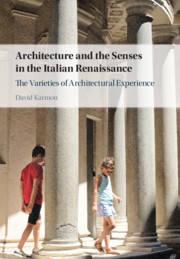122 results
Chapter 5 - Poetic Form: Soundscapes
- from Part I - Literary Contexts
-
-
- Book:
- A History of World War One Poetry
- Published online:
- 18 January 2023
- Print publication:
- 12 January 2023, pp 79-96
-
- Chapter
- Export citation
Acoustic speech markers for schizophrenia-spectrum disorders: a diagnostic and symptom-recognition tool
-
- Journal:
- Psychological Medicine / Volume 53 / Issue 4 / March 2023
- Published online by Cambridge University Press:
- 04 August 2021, pp. 1302-1312
-
- Article
-
- You have access
- Open access
- HTML
- Export citation

Architecture and the Senses in the Italian Renaissance
- The Varieties of Architectural Experience
-
- Published online:
- 30 April 2021
- Print publication:
- 27 May 2021
The role of a virtual telephone clinic in the follow-up management of lateral skull base tumours
-
- Journal:
- The Journal of Laryngology & Otology / Volume 134 / Issue 12 / December 2020
- Published online by Cambridge University Press:
- 17 December 2020, pp. 1081-1084
- Print publication:
- December 2020
-
- Article
- Export citation
Chapter Three - Interaction between Oscillations and Waves
-
- Book:
- Ocean Waves and Oscillating Systems
- Published online:
- 12 May 2020
- Print publication:
- 28 May 2020, pp 46-61
-
- Chapter
- Export citation
Chapter 15 - Respiratory Monitoring in Low-Intensity Settings
-
-
- Book:
- Modern Monitoring in Anesthesiology and Perioperative Care
- Published online:
- 28 April 2020
- Print publication:
- 07 May 2020, pp 148-153
-
- Chapter
- Export citation
7 - Phonetics
- from Part 3 - ‘The deep grooves of language’
-
- Book:
- For the Love of Language
- Published online:
- 13 December 2019
- Print publication:
- 12 November 2019, pp 178-216
-
- Chapter
- Export citation
Ultrasonic welding of AZ31B magnesium alloy
-
- Journal:
- MRS Bulletin / Volume 44 / Issue 8 / August 2019
- Published online by Cambridge University Press:
- 05 August 2019, pp. 630-636
- Print publication:
- August 2019
-
- Article
- Export citation
The Necessity, Promise and Challenge of Automated Biodiversity Surveys
-
- Journal:
- Environmental Conservation / Volume 46 / Issue 4 / December 2019
- Published online by Cambridge University Press:
- 18 July 2019, pp. 247-250
-
- Article
- Export citation
Materials synthesis in a bubble
-
- Journal:
- MRS Bulletin / Volume 44 / Issue 5 / May 2019
- Published online by Cambridge University Press:
- 09 May 2019, pp. 382-391
- Print publication:
- May 2019
-
- Article
- Export citation
Acoustic enhancement of surface reactions
-
- Journal:
- MRS Bulletin / Volume 44 / Issue 5 / May 2019
- Published online by Cambridge University Press:
- 09 May 2019, pp. 361-371
- Print publication:
- May 2019
-
- Article
- Export citation
Acoustic processes in materials
-
- Journal:
- MRS Bulletin / Volume 44 / Issue 5 / May 2019
- Published online by Cambridge University Press:
- 09 May 2019, pp. 345-349
- Print publication:
- May 2019
-
- Article
-
- You have access
- HTML
- Export citation
Transient grating spectroscopy: An ultrarapid, nondestructive materials evaluation technique
-
- Journal:
- MRS Bulletin / Volume 44 / Issue 5 / May 2019
- Published online by Cambridge University Press:
- 09 May 2019, pp. 392-402
- Print publication:
- May 2019
-
- Article
- Export citation
Laser-induced acoustic desorption
-
- Journal:
- MRS Bulletin / Volume 44 / Issue 5 / May 2019
- Published online by Cambridge University Press:
- 09 May 2019, pp. 372-381
- Print publication:
- May 2019
-
- Article
- Export citation
Nonlinear acoustics in studies of structural features of materials
-
- Journal:
- MRS Bulletin / Volume 44 / Issue 5 / May 2019
- Published online by Cambridge University Press:
- 09 May 2019, pp. 350-360
- Print publication:
- May 2019
-
- Article
- Export citation
Time-domain Brillouin Scattering as a Local Temperature Probe in Liquids
-
- Journal:
- MRS Advances / Volume 4 / Issue 1 / 2019
- Published online by Cambridge University Press:
- 02 January 2019, pp. 9-14
- Print publication:
- 2019
-
- Article
- Export citation
Design of honeycomb structures with tunable acoustic properties
-
- Journal:
- MRS Advances / Volume 4 / Issue 44-45 / 2019
- Published online by Cambridge University Press:
- 17 September 2019, pp. 2409-2418
- Print publication:
- 2019
-
- Article
- Export citation
In Situ Accurate Analysis of Colloidal Nanoparticles via Four Wave Mixing
-
- Journal:
- MRS Advances / Volume 3 / Issue 14 / 2018
- Published online by Cambridge University Press:
- 02 January 2018, pp. 707-709
- Print publication:
- 2018
-
- Article
- Export citation
Designer matter: Fascinating interactions of light and sound with metamaterials
-
- Journal:
- MRS Bulletin / Volume 42 / Issue 9 / September 2017
- Published online by Cambridge University Press:
- 08 September 2017, pp. 677-682
- Print publication:
- September 2017
-
- Article
- Export citation
Effects of thiocolchicoside, a commonly used myorelaxant, on the acoustic reflex
-
- Journal:
- The Journal of Laryngology & Otology / Volume 131 / Issue 6 / June 2017
- Published online by Cambridge University Press:
- 02 March 2017, pp. 497-500
- Print publication:
- June 2017
-
- Article
- Export citation

